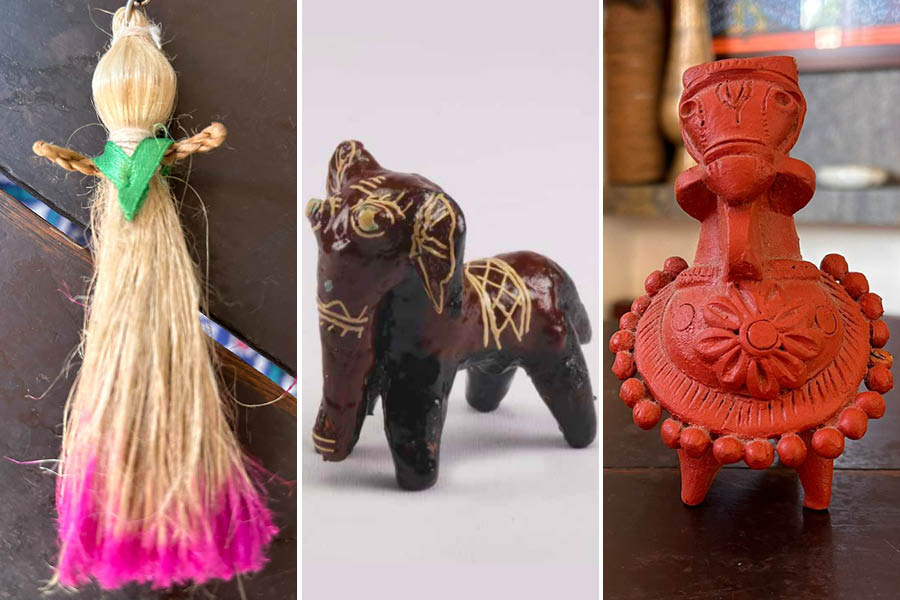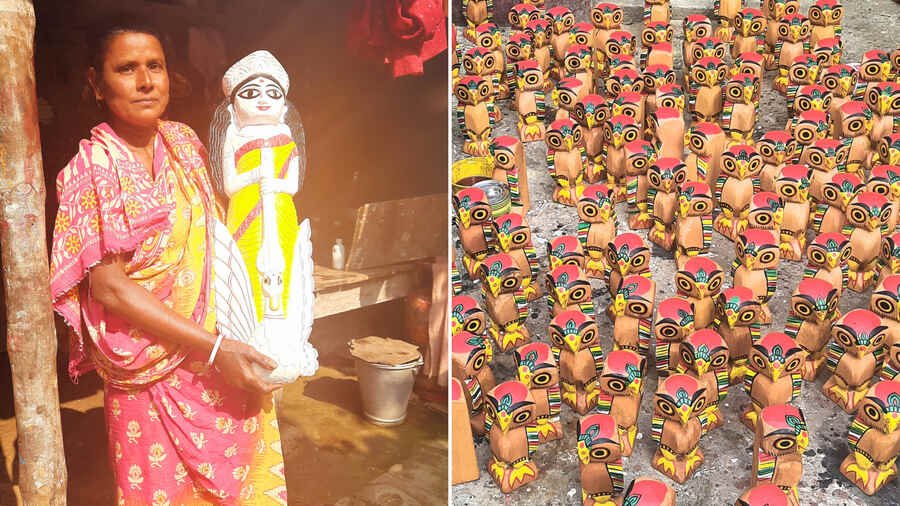If you are a millennial and have lived on the outskirts of urban Bengal — in the mofussil towns or in rural Bengal — chances are that you came across people with baskets on their head, calling in a sing-a-song tone — “putul chai, putul…?” The baskets had clay or earthen dolls. Many of us also have memories of our grandmothers and mothers making ragtag dolls for us with discarded clothes.
Bengal has a rich history of doll-making. The variety, in terms of the concept and materials used to make the dolls, is diverse. Though on the wane now, places like Nutangram in Purba Bardhaman are still carrying forward a generational legacy in doll-making. On the occasion of World Doll Day on June 8, My Kolkata takes you through the various types of dolls made in West Bengal.
Clay dolls
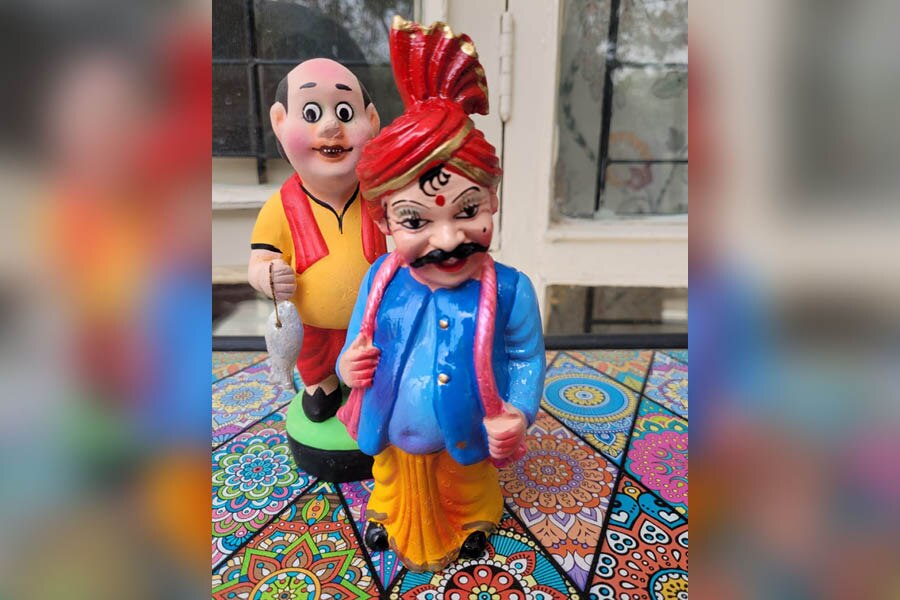
Gopal Bhnar and another figure in clay. Rumela Basu’s personal collection
Clay dolls or matir putul are one of the oldest forms of dolls, dating back to undivided Bengal. Clay dolls come in two types here, soft clay dolls and fired clay rolls. Soft clay dolls are sun dried and given shape, facial structure and patterns, depending on the design. The colour is that of the soil or the dolls are coloured using natural or artificial colours. The fire-glazed ones are put in the kiln. Nowadays, many contemporary sculptures from Bengal are using the Raku technique while making figurines.
Clay dolls is an umbrella term. The types that fall under it carry with them folklores, oral history, traditional beliefs, cultural heritage of the artisan communities and documented history. Krishnanagar in Nadia is popular for its clay dolls. A few popular types of dolls made with clay are:
- Sasthi dolls: If you have read Khirer Putul by Abanindranath Tagore, you know about Sasthi Thakrun and her children. Bengal has been making Sasthi dolls, but with a social messaging about the working class. Mostly made in Coonoor in North Dinajpur, these are figures of a mother and a son. The mother is a working woman with a basket on atop her head, and son on her lap
- Jhulan dolls: Petite figurines made of clay to decorate the swing of Krishna and Radha are popular even in today’s time. The Jhulan dolls that are made in Kumartuli and Kalighat of Kolkata usually represent everyday sights like a park or a policeman. Mythological characters like Radha-Krishna or Shiva-Parvati are also depicted through them. Janmashtami also brings many Jhulan dolls to life through Krishnaleela anecdotes or Kansa vadh. Bon bibi and Dakshin Rai are popular clay dolls in the Sunderbans, although they are not related to the Jhulan or Janmashtami festivals
- Tusu dolls: Popular in Bankura and Purulia, the Tusu dolls are worshipped in the form of Tusu goddess during the Tusu festival in Poush Sankranti. The facial features are thick brows, prominent eyes, and a nose ring. Colourful saris adorn the deity. Today, modern figures are also made in Tusu dolls
- Jo dolls: From Medinipur, Jo dolls are black in colour and the facial features of the figures resemble Garuda — the Hindu deity. The women patua artisans make these dolls, and are a set of a mother and a child. Also popular are the Beni dolls. Beni means braids. The dolls are used for puppet dancing, and have evolved from being made with palm seeds and bamboo to clay and wood
- Kanthalia dolls: These dolls depict daily life and seemingly mundane things like a woman giving a child a massage, pulses being pounded, a milkman at work and alike. The stripes on the bodies and the use of red and black on the dolls set them apart from other clay dolls. To give these dolls the final finish, chalk dust and mica is used
- Nodding dolls: Bobble heads made with clay, the figures have cute faces and the limbs are attached to the body with the help of springs. The precision of assemblance is a marvel in itself
Terracotta dolls
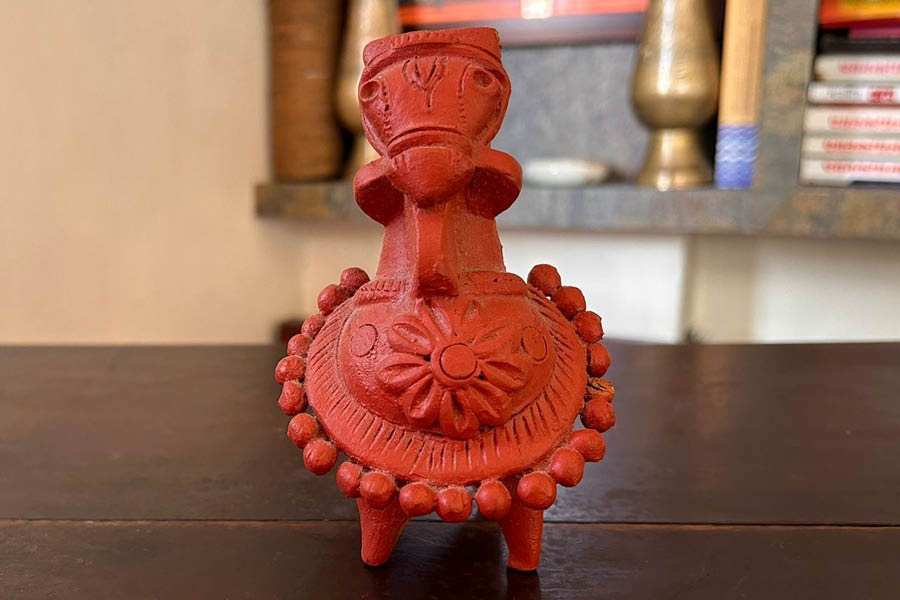
A terracotta horse. Pooja Mitra’s personal collection
A form of clay dolls, terracotta is the most popular of the family and deserves a separate mention. From animals to mythological characters, shankha to decorative utensils — the artisans who work with terracotta offer a wide gamut of options. Terracotta items are a collector’s delight and are also great for home decor enthusiasts. While they are available in many parts of Bengal, if you are planning a trip to the Joypur forest anytime soon, the shop outside the Banalata eatery has terracotta artefacts that will surprise you.
Cloth dolls
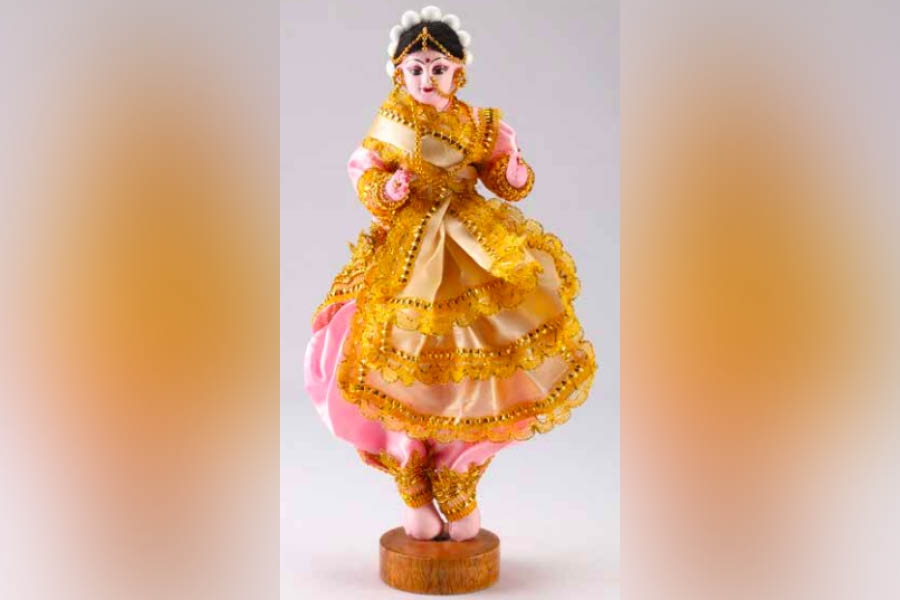
A dancer made up of rags. Biswa Bangla
Made with rags or discarded clothes, the cloth dolls have been in Bengal generationally. Easy to make, they are usually stuffed with tattered clothes or cotton, with the head sewn to the body, and facial features painted. In today’s age of plastic affecting the environment, cloth dolls are a sustainable option and have a longer longevity too.
Palm leaf dolls

These dolls are eco-friendly and can be DIY projects for children under adult supervision. Biswa Bangla
Talpatar sepai or palm leaf dolls have been a playmate of children for ages. Not widely used now, the dolls have moveable limbs attached to the body with strings. The figures represent humans, and animals are also made, although not widely. These dolls are eco-friendly and can be DIY projects for children under adult supervision.
Shellac dolls
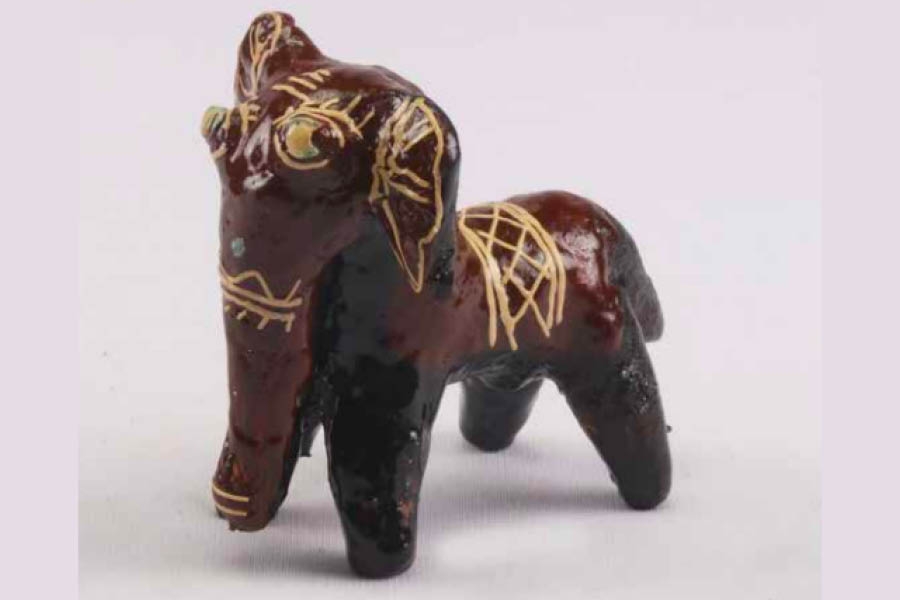
Mythological characters, wildlife, religious festivals are the common topics for shellac dolls. Biswa Bangla
Shellac dolls or galar putul hail from Purba Medinipur. The dolls are usually made with soil from white ant hills. Hand-pressing technique is used to give the shapes, and then the shellac dolls are sun baked and later dried, and then coloured with shellac colours and glazed. Mythological characters, wildlife, religious festivals are the common topics for shellac dolls. Shellac jewellery has gained popularity over the time too.
Wooden dolls

A couple of wooden owls perched on a money plant pot. Pooja Mitra’s personal collection
Nutangram in Bardhaman is the most visited place in West Bengal for wooden dolls. The carpenter community mostly makes these dolls, and they range from animals to human figure and mythological characters. The wood is mostly from the white teak tree. The dolls are carved, painted and polished. Owl wooden dolls are a huge hit among wooden dolls.
Dokra dolls
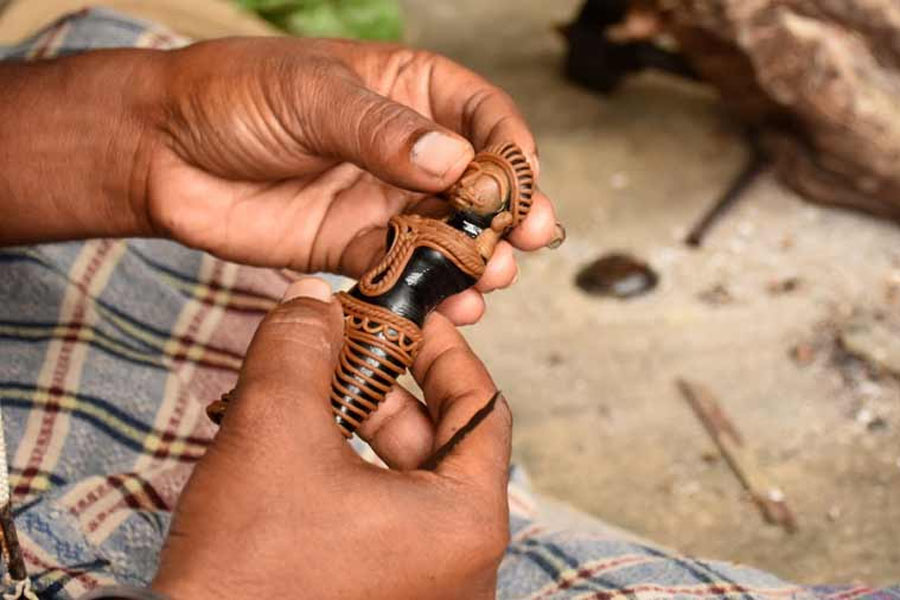
TT Archives
Dokra dolls are made with lost wax casting and the technique originates from the Dokra Dhamar tribe. West Bengal and Odisha make dokra dolls and other dokra items in large numbers. Handcrafted and made with brass, and then metal casted, the base of the artefacts are clay, over which wax is poured. After this stage, the finer detailing is done, and then another layer of clay is added, and the dolls are then sun dried. The last stage is pouring molten brass.
Did you know dokra dates back to the Indus Valley Civilisation and came to Bengal approximately 3,500 years ago?
Metallic dolls
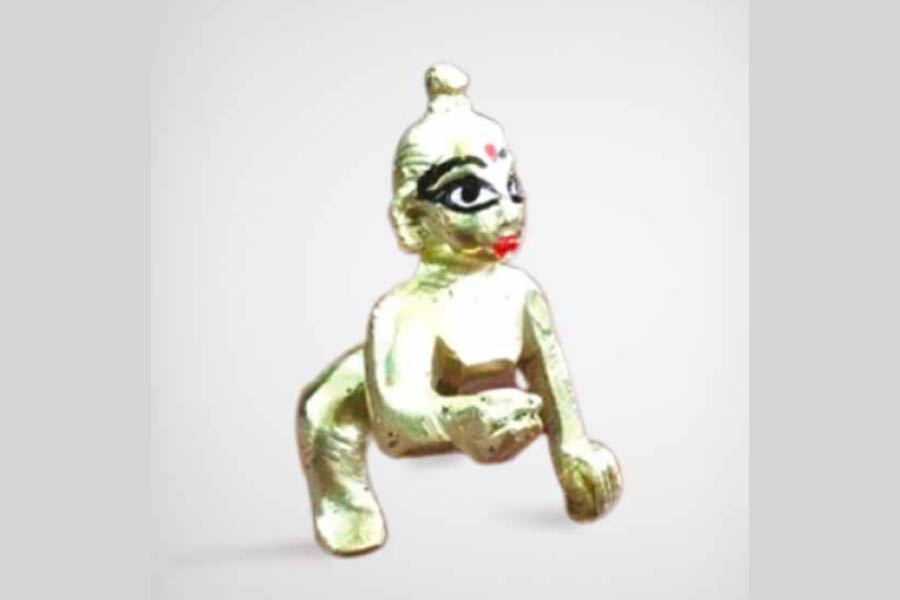
An idol of Gopal in metal. Biswa Bangla
If you have Gopal at home, it is made of metal or dhatu. Metallic dolls have various types, for example Gopal can also be made with ashtadhatu or eight types of metals. The dolls are made through metal casting, and then polished.
Jute dolls

The figure of a girl in jute. Pooja Mitra’s personal collection
Another eco-friendly option when it comes to dolls are jute dolls. West Bengal is the largest producer of jute in India. The dolls are made with discarded jute. Murshidabad contributes in large numbers when it comes to jute products. The method of making has evolved over time and today dyed jute fibre is used to make these dolls.
Porcelain dolls
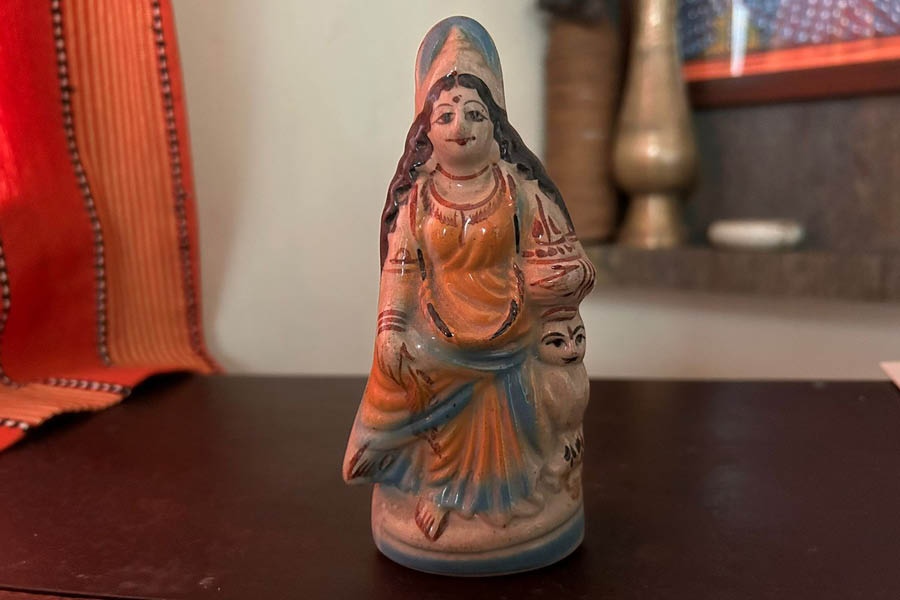
A Lakshmi idol in porcelain. Pooja Mitra’s personal collection
Dating back to the British era, porcelain dolls can be found in households who had a knack in porcelain figures from the yesteryears. Putuler biye in many affluent households were celebrated with porcelain dolls. The popularity gave birth to the porcelain industry in Bengal. During the Swadeshi movement, the porcelain industry also produced Swadeshi porcelain items.
